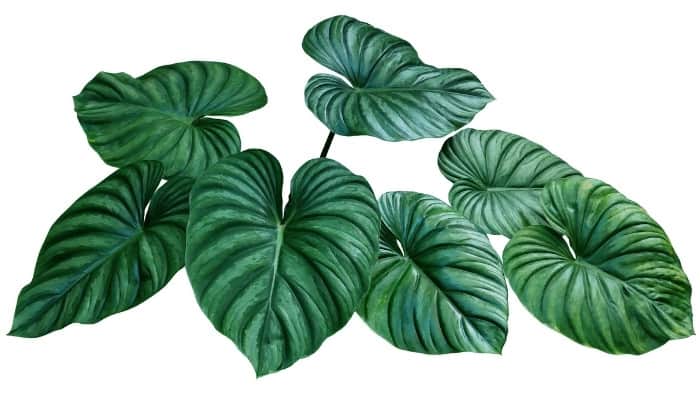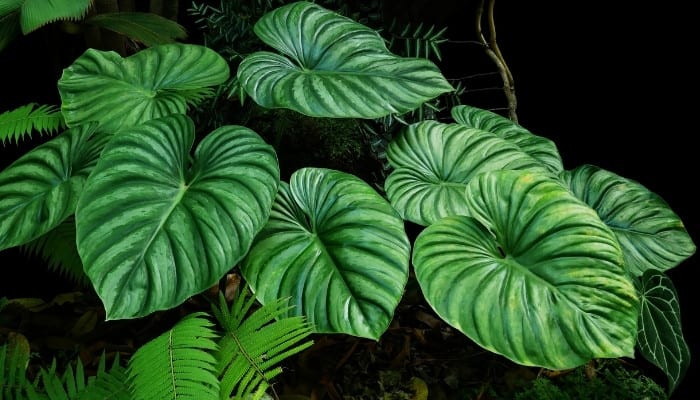The Philodendron plowmanii is originally from the warm, tropical regions of Central and South America, and thrives in the comfortable climates of Peru and Ecuador.
This gorgeous creeping beauty belongs to the Araceae family. Its leathery heart-shaped, glossy leaves are a mix of yellow and green shades with silvery streaks.
Popular among plant lovers, the Philodendron plowmanii is super easy to grow and will add that splash of tropical ambiance to any home!
How do you care for a Philodendron Plowmanii? Provide the plant with access to plenty of bright, indirect light, and ensure temperatures are greater than 55℉ (12℃). The soil should be a well-draining potting mix kept moist but not waterlogged. Ideally, humidity levels should be 65-75%, but occasional misting is acceptable.
Use our super-easy care guide below for optimum growth results, and watch your Philodendron plowmanii flourish!
Philodendron Plowmanii Care
This slow-growing tropical beauty is extremely low maintenance and requires very little in terms of care and cosseting.
Therefore, you only need to follow the basic care guidelines given below to ensure this moisture-loving plant continues to thrive in its indoor environment.
What To Do When You First Get Your Philodendron Plowmanii
Check that the nursery container is suitably sized and that the plant has not become root bound, and check that the soil is moist but not soggy.
Next, place the plant in a warm position where it has access to plenty of bright, indirect light.
Ideal Soil
The Philodendron plowmanii enjoys rich, organic soil. The soil should drain quickly to prevent root rot with a pH of 4.5-6. If mixing your own potting soil, use equal parts peat, sand, and loam.
Lighting, Humidity & Temperature for Philodendron Plowmanii
In its natural habitat, the Philodendron plowmanii is found beneath the forest canopy in the shade of taller plants and trees.
While it enjoys access to bright indirect light, direct sunlight will burn its leaves. To prevent this, use a shade cloth, blind or sheer curtain to filter sunlight light if needed.
The humidity levels should be kept above 65% as this plant thrives in humid conditions.
For plant parents living in drier zones, use a humidifier (I prefer this model because of the rotating nozzle and quiet operation) or place the plant on a pebble tray to increase the humidity levels.
You can also group plants to increase humidity naturally.
As a tropical plant, the Philodendron plowmanii enjoys warmer temperatures of 55℉ (12℃) and more. It is not frost or cold hardy and will require protection from sudden temperature drops.
Place the plant away from cold drafts and bring it indoors when temperatures dip below 55℉.
Watering and Fertilizing Philodendron Plowmanii
The Philodendron plowmanii is a moisture-loving, tropical plant that requires regular soakings. While the soil should drain quickly, it must be kept moist.
This plant is not drought resistant, and overly dry soil can negatively impact its growth. Check that the top 2 inches of soil are dry between soakings to avoid overwatering.
Plant parents usually find they need to provide water once or twice a week to keep the soil adequately moist.
The Philodendron plowmanii can grow well without regular fertilizing.
However, providing fertilizer during the growing season using a quality liquid fertilizer (I recommend this organic food) will enhance the plant’s growth.
Potential Issues
As with any plant, if the proper care is not provided, it can lead to potential issues with your plant resulting in disease or attraction of pests.
These can impact the growth and health of the plant.
Mealybugs
These bugs tend to live in clusters on the plant’s leaf axils, stems, and even roots. They suck the sap from the plant and produce a sticky honeydew on the leaf surface.
This causes black sooty mold to grow on the leaves, which inhibits growth and causes the foliage to drop off prematurely.
Check the plant regularly for signs of mealybugs and remove dead or damaged foliage.
Using a spray bottle, mix equal parts vegetable oil, dishwashing soap, and water, and apply to the foliage for control.
Aphids
These are sap-sucking pests that produce a sticky residue on the leaf surface that leads to subsequent growth of sooty molds. Symptoms include stunted growth and leaf curl.
Regularly inspect the plant for signs of aphids, and as a preventative, regularly wipe the leaf surface, undersides, and nodes with 70% Isopropyl alcohol.
Alternatively, mix equal parts onion, garlic, and cayenne pepper, and spray onto the foliage to combat aphid infestations.
Pseudomonas Leaf Spot
High temperature and humidity levels can cause the plant to be attacked by pseudomonas bacteria. As a result, the leaves develop yellow lesions with black or dark centers.
Ensure you are not overwatering the plant; check the top 2 inches of soil are dry between soakings. Keep humidity levels at 65%.
This plant enjoys being misted, but over misting can cause this leaf disease to develop.
Erwinia Blight
Overwatering can cause the Philodendron plowmanii to develop Erwinia blight. As a result, the leaves become pale and yellowish while growth becomes stunted and weak.
Reduce the watering schedule, providing additional water only when the top layer of soil is dry to the touch.
Check the soil is draining quickly, and do not allow the plant container to stand in pooled water. Ensure the excess water drains well and empty the drip tray if any water accumulates.
Xanthomonas Leaf Spot
Damaged foliage coupled with high temperature and humidity levels can result in the development of Xanthomonas bacteria. This causes the foliage to yellow and wilt.
Ensure damaged foliage is pruned as this is where the bacteria enter the plant.
Keep the plant in a warm area with a temperature between 55 and 85℉ (12- 29℃). Humidity levels should be at approximately 65%.

Is Philodendron Plowmanii Rare?
Originating from the depths of the tropical rainforest, not all Philodendrons are readily available to purchase.
As a result, some are sold by plant collectors who may attach hefty price tags.
While the Philodendron plowmanii is considered a rare type of Philodendron, it can be purchased online for approximately $85.
Is Philodendron Plowmanii a Climber or a Crawler?
The Philodendron plowmanii is a creeping Philodendron variety. The stems grow along the ground providing a base for the plant rather than supporting the leaves.
How Big Does Philodendron Plowmanii Grow?
Philodendron plowmanii can reach a height of approximately 8 feet with the right level of care, but this can take quite a long time.
When grown outdoors in warmer zones, this plant can become very large compared to when grown in a container.
Is Philodendron Plowmanii a Slow Grower?
While soil, light, and temperature may affect the growth rate of the Philodendron plowmanii, it is also naturally considered a slow grower.
Therefore, provide the plant with access to bright, indirect light; well-draining soil; and warm, humid conditions for optimum growth results.
How Do You Repot a Plowmanii?
Even though this plant is slow to grow, the Philodendron plowmanii does not enjoy being rootbound.
Rootbound symptoms include slower than average growth rates and roots appearing through the container drainage holes or above the soil surface.
When repotting, select a new container 2 centimeters larger than the older container and half fill with rich, organic soil.
A good soil mixture should include peat, sand, and loam.
Gently remove the plant from its old container, and using your fingers, loosen the compacted soil from around the roots.
Next place the plant into the new container half-filled with fresh soil.
Finish filling the container with soil until full and press firmly down around the base of the plant. Water thoroughly until the excess water drains from the container.
Then, continue to care for your plant as per the usual guidelines.
Is Plowmanii a Hybrid?
No, the Philodendron plowmanii is not a hybrid. A hybrid plant is grown from the seed produced when cross-pollinating two different plant varieties.
The Philodendron plowmanii x tenue is an excellent example of a hybrid. It has long, bright-green leaves and deep-set veins compared to its parent, the Philodendron plowmanii.
Is Philodendron Plowmanii Variegated?
The leaves of the Philodendron plowmanii are described as bicolorous (two tonal) in varying shades of green.
However, its leaves do not display patches of varying colors associated with variegation.
Does Philodendron Plowmanii Flower?
It is rare for the Philodendron plowmanii to flower, but it may produce unscented, yellow clusters or spathes of flowers.
Compared to the plant’s foliage, the flowers are insignificant in size and appearance, and they often go unnoticed.
Philodendron Mamei vs. Plowmanii
These plants are similar in appearance but have two distinct differences. First, the Philodendron plowmanii has ruffled or wavy-edged petioles, while the P. mamei’s are not.
Secondly, the Philodendron mamei has silvery variegations on its leaves which are not present on the Philodendron plowmanii.
Philodendron Plowmanii vs. Pastazanum
The Philodendron plowmanii and Philodendron pastazanum are both creepers and grow along the ground. Their foliage is also similar and heart shaped.
However, the plowmanii’s leaves are a deeper green with dark veining, and the pastazanum’s leaves are lighter in hue with white veining.
How Much Does Philodendron Plowmanii Cost?
The Philodendron plowmanii can be purchased online for approximately $85-$100. However, this price tag can be higher due to high demand and low availability.
How Do You Propagate Philodendron Plowmanii?
You can propagate the Philodendron plowmanii with stem cuttings in soil or water. Propagation can be done with seed, but this is not a popular method as it involves a lengthy process.
Water Propagation
Using sterilized scissors, select a 4-5 inch stem cutting that includes at least two leaf nodes. Place the cutting into a jar of clean water, ensuring the water covers the bare nodes.
Three to four leaves should be above the waterline. Next, place the cutting in a warm area out of direct sunlight. Change the water regularly.
Once the cutting has rooted and the roots are at least 2 inches long, you can transplant it into the soil. Continue to care for the plant by following the usual care guidelines.
Soil Propagation
Select a 4-5 inch cutting with at least three or four leaf nodes. Dip the severed end of the cutting into a rooting hormone (I’ve always had good results with this one).
Next, place the cutting into a plant container filled with well-draining potting mix, and water well.
Cover the container with a clear plastic bag to ensure the cutting receives adequate warmth and moisture.
Lift the bag off the plant regularly to provide access to air and prevent bacterial infection. Roots should develop in approximately four weeks.
Once the cutting has rooted, transplant it into a larger container if needed. Continue to provide the same care as required by the parent plant.
Conclusion
The Philodendron plowmanii is a fascinating and beautiful addition to any plant family.
Its low maintenance requirements, chilled growth habits, and stunning foliage have plant parents around the world clamoring to add it to their collection.
Use the guidelines above to keep your plowmanii in tip-top tropical condition!

